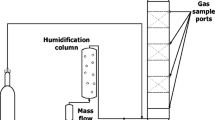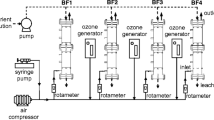Abstract
Biological treatment systems such as biofilters offer a potential alternative to the existing physicochemical techniques for the removal of volatile organic compounds from gaseous emissions. In this experimental work, continuous phase biofiltration of xylene vapors were performed in a laboratory scale compost biofilter that was inoculated with a xylene-acclimatized consortium. The performance was assessed by continuously monitoring the removal efficiency (RE) and elimination capacity (EC) of the biofilter at loading rates varying between 2–220 g m−3 h−1. The steady-state removal efficiencies were maintained between 60% and 90% up to a loading rate of 80 g m−3 h−1. The removal efficiency decreased significantly at loading rates higher than 100 g m−3 h−1. The pressure drop values were consistently less and insignificant in affecting the performance of the system. The present study also focuses in evaluating the stability of biofilter during shut down, restart, and shock-loading operations. An immediate restoration of biological activity after few days of starvation indicated their capability to handle discontinuous treatment situations which is more common to industrial biofilters. The sensitiveness of the biofilm to withstand shock loads was tested by abruptly increasing/decreasing the loading rates between 9–55 g m−3 h−1, where, removal efficiencies between 60–90% were achieved. These results prove the resilience of the biomass and the stability of the compost biofilter. Anew, results from kinetic analysis reveal that, steady-state xylene removal in the biofilter can be adequately represented by Michaelis–Menten type kinetics, and the kinetic constants namely, ECmax (120.4 g m−3 h−1) and K s (2.21 g m−3) were obtained.











Similar content being viewed by others
References
Allen, E. R., & Phatak, S. (1993). Control of organo-sulfur compound emissions using biofiltration–methyl mercaptans. In: Proceedings of the 86th Annual Meeting and Exhibition of the Air and Waste Manage. Assoc., Pittsburg, PA.
Apel, W. A., Dugan, P. R., Weibe, M. R., Johnson, E. G., Wolfram, J. H., & Rogers, R. D. (1995). Bioprocessing of environmentally significant gases and vapors with gas phase bioreactors. In: Emerging technologies in hazardous waste management, ACS Symposium, 518, 411–428.
APHA. (1985). In A. E. Greenberg, L. S. Clesceri & A. D. Eaton (Eds.), Standard methods for the examination of water and wastewater (16th ed.). Washington: APHA.
Arulneyam, D. (1999). Biodegradation of volatile organic vapours in biofilter. Ph.D Thesis, Submitted to the Dept Chem. Eng., IIT Madras.
Arulneyam, D., & Swaminathan, T. (2004). Biodegradation of mixture of VOC’s in a biofilter. Journal of Environmental Science, 16, 30–33.
Bibeau, L., Kiared, K., Brzezinski, R., Viel, G., & Heitz, M. (2000). Treatment of air polluted with xylenes using a bioreactor. Water, Air and Soil Pollution, 118, 377–394.
Chen, Y.-X., Yin, J., & Wang, K.-X. (2005). Long – term operation of biofilters for biological removal of ammonia. Chemosphere, 58, 1023–1030.
Corsi, R. L., & Seed, L. P. (1994). Biofiltration of BTEX contaminated gas streams: Laboratory studies. In: Proceedings of the 87th Annual Meeting and Exhibition of the Air and Waste Manage. Assoc. Cincinnati, Ohio.
Cox, H. H. J., & Deshusses, M. A. (2002). Effect of starvation on the performance and re – acclimation of biotrickling filters for air pollution control. Environmental Science and Technology, 36, 3069–3073.
Cox, H. H. J., Moerman, R. E., Van Baalen, S., Van Heiningen, W. N. M., Doddema, H. J., & Harder, W. (1997). Performance of a styrene degrading biofilter containing the yeast Exophiala jeanselmei. Biotechnology and Bioengineering, 53, 259–266.
Delhomenie, M. C., Bibeau, L., Bredin, N., Roy, S., Broussau, S., & Brezezinski, R. (2002). Biofiltration of air contaminated with toluene on a compost based bed. Advances in Environmental Research, 6, 239–254.
Deshusses, M. A. (1994). Biodegradation of mixtures of ketone vapours in biofilters for the treatment of waste air. Ph.D Dissertation submitted to the Swiss Federal Institute of Technology, Zurich, Diss. ETH Nr. 10633.
Deshusses, M. A. (1997). Transient behavior of biofilters: Start – up, carbon balances, and interactions between pollutants. Journal of Environmental Engineering, 123, 563–568.
Devinny, J. S., Deshusses, M. A., & Webster, T. S. (1999). Biofiltration for air pollution control. Boca Raton: Lewis.
Du Plessis, C. A., Strauss, J. M., & Riedel, K.-H. J. (2001). BTEX catabolism interactions in a toluene acclimatized biofilter. Applied Microbiology and Biotechnology, 55, 122–128.
Elmrini, H., Bredin, N., Shareefdeen, Z., & Heitz, M. (2004). Biofiltration of xylene emissions: Bioreactor response to variations in the pollutant inlet concentration and gas flow rate. Chemical Engineering Journal, 100, 149–158.
Ergas, S. J., Kinney, K., Fuller, M. E., & Scow, K. M. (1994). Characterization of a compost biofiltration system degrading dichloromethane. Biotechnology and Bioengineering, 44, 1048–1054.
Gabaldon, G., Martinez-Soria, V., Martin, M., Marzal, P., Penya-Roja, J.-M., & Alvarez-Hornos, F. J. (2005). Removal of TEX vapours from air in a peat biofilter: Influence of inlet concentration and inlet load. Journal of Chemical Technology and Biotechnology, 81, 322–328.
Graham, J. R. (1996). GAC based gas phase biofiltration. In: Proceedings of the 1996 Conference on Biofiltration, The Reynolds Group, Tustin, CA, 85.
Jenkin, M. E., & Clemitshaw, K. C. (2000). Ozone and other secondary photochemical pollutants: Chemical processes governing their formation in the planetary boundary layer. Atmospheric Environment, 34, 2499–2527.
Jin, Y., Veiga, M. C., & Kennes, C. (2005). Effects of pH, CO2, and flow pattern on the autotrophic degradation of hydrogen sulfide in a biotrickling filter. Biotechnology and Bioengineering, 92, 462–471.
Jorio, H., Kiared, K., Brzezinski, R., Leroux, A., Viel, R., & Heitz, M. (1998). Treatment of air polluted with high concentrations of toluene and xylene in a pilot scale biofilter. Journal of Chemical Technology and Biotechnology, 73, 183–196.
Jorio, H., Bibeau, L., Viel, G., & Heitz, M. (2000). Effects of gas flow rate and inlet concentration on xylene vapors biofiltration performance. Chemical Engineering Journal, 76, 209–221.
Kennes, C., & Veiga, M. C. (2001). Conventional biofilters. In C. Kennes & M. C. Veiga (Eds.), Bioreactors for waste gas treatment (pp. 47–98). Dordrecht: Kluwer.
Kennes, C., Cox, H. H. J., Doddema, H. J., & Harder, W. (1996). Design and performance of biofilters for the removal of alkylbenzene vapours. Journal of Chemical Technology and Biotechnology, 66, 300–304.
Kennes, C., Rene, E. R., & Viega, M. C. (2009). Bioprocesses for air pollution control. Journal of Chemical Technology and Biotechnology, 84, 1419–1436.
Khan, F. I., & Ghoshal, A. K. (2000). Removal of volatile organic compounds from polluted air. Journal of Loss Prevention in the Process Industries, 13, 527–545.
Liu, Y., Quan, X., Sun, Y., Chen, J., Xue, D., & Chung, J. S. (2002). Simultaneous removal of ethylacetate and toluene in air streams using compost based biofilters. Journal of Hazardous Materials, B95, 199–213.
Marek, J., Paca, J., & Gerrard, A. M. (2000). Dynamic responses of biofilters to changes in the operating conditions in the process of removing toluene and xylene from air. Acta Biotechnologica, 20, 17–29.
Martin, F. J., & Loehr, R. C. (1996). Effect of periods of non – use on biofilter performance. Journal of the Air & Waste Management Association, 46, 539–546.
McNevin, D., & Barford, J. (2000). Biofiltration as an odour abatement strategy. Biochemical Engineering Journal, 5, 231–242.
Miller, D. E., & Canter, L. W. (1991). Control of aromatic waste air streams by soil bioreactors. Environmental Progress, 10, 300–306.
Prevot, A. S. H., Dommen, J., Bäumle, M., & Furger, M. (2000). Diurnal variations of volatile organic compounds and local circulation systems in an Alpine valley. Atmospheric Environment, 34, 1413–1423.
Raghuvanshi, S., & Babu, B. V. (2009). Experimental studies and kinetic modeling for removal of methyl ethyl ketone using biofiltration. Bioresource Technology, 100, 3855–3861.
Rene, E. R., Arulneyam, D., & Swaminathan, T. (2004). Biofiltration. In A. Pandey (Ed.), Concise encyclopedia of bioresource technology (pp. 31–39). New York: Haworth.
Rene, E. R., Murthy, D. V. S., & Swaminathan, T. (2005). Performance evaluation of a compost biofilter treating toluene vapours. Process Biochemistry, 40, 2771–2779.
Saravanan, V., & Rajamohan, N. (2009). Treatment of xylene polluted air using press mud – based biofilter. Journal of Hazardous Materials, 162, 981–988.
Strauss, J. M., Riedel, K. J., & du Plessis, C. A. (2004). Mesophilic and thermophilic BTEX substrate interactions for a toluene acclimatized biofilter. Applied Microbiology and Biotechnology, 64, 855–861.
Tang, H.-M., & Hwang, S.-J. (1997). Transient behaviour of the biofilters for toluene removal. Journal of the Air & Waste Management Association, 47, 1142–1151.
Tautz, H., Bronnenmeier, R., Frank, P., & Zeller, B. (1992). Hochleistungsbiofilter Vortragsunterlagen zum Seminar Mikrobiologische Verfahrenstechniken zur Umweltsanierung. Wuppertal: Linde.
Torronen, M. E., Lehtomaki, J. T., & Laukkarinen, A. H. (1992). A feasibility study of biological waste air purification in cold climate. In: Proceedings of the 9th World Clean Air Congress.
van Lith, C., & Standefer, S. (1993). Biofilters minimize VOC emissions. Environmental Protection, 48–51, March.
Wang, Z., Govind, R., & Bishop, D. F. (1996). Review of biofiltration – effect of support media on biofilter performance. In: Proceedings of the 89th Annual Meeting and Exhibition of the Air and Waste Manage. Assoc., Nashville, Tennessee.
Wani, A. H., Branion, A. M. R., & Lau, A. K. (1998). Effect of periods of starvation and fluctuating hydrogen sulphide concentration on biofilter dynamics and performance. Journal of Hazardous Materials, 60, 287–303.
Welcher, F. J. (1975). Standard methods of chemical analysis, vol. 2, part B (6th ed.). Malabar: Krieger.
WHO (1981). Recommended health – based limits in occupational exposure to selected organic solvents, Geneva, World Health Organization. In: Technical Report Series 664.
Zilli, M., Converti, A., Lodi, A., Del Borgi, M., & Ferraiolo, G. (1993). Phenol removal from waste gases with a biological filter by Pseudomonas putida. Biotechnology and Bioengineering, 41, 693–699.
Zilli, M., Del Borgi, A., & Converti, A. (2000). Toluene vapour removal in a laboratory scale biofilter. Applied Microbiology and Biotechnology, 54, 248–254.
Acknowledgements
This biofiltration research was carried out using the partial research grants received from the Swedish International Development Agency (SIDA) under the project CHE/01-02/054/SIDA/DVSM and the Department of Chemical Engineering, IIT Madras. We are grateful to Mr. K. Narayana Rao and Mr. Z. Aslam Basha, Department of Chemical Engineering and Department of Biotechnology IIT Madras for their analytical help.
Author information
Authors and Affiliations
Corresponding author
Rights and permissions
About this article
Cite this article
Rene, E.R., Murthy, D.V.S. & Swaminathan, T. Effect of Flow Rate, Concentration and Transient—State Operations on the Performance of a Biofilter Treating Xylene Vapors. Water Air Soil Pollut 211, 79–93 (2010). https://doi.org/10.1007/s11270-009-0282-7
Received:
Accepted:
Published:
Issue Date:
DOI: https://doi.org/10.1007/s11270-009-0282-7




